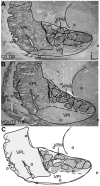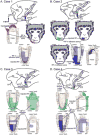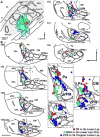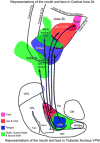Thalamic input to representations of the teeth, tongue, and face in somatosensory area 3b of macaque monkeys
- PMID: 23873330
- PMCID: PMC3893768
- DOI: 10.1002/cne.23386
Thalamic input to representations of the teeth, tongue, and face in somatosensory area 3b of macaque monkeys
Abstract
Representations of the parts of the oral cavity and face in somatosensory area 3b of macaque monkeys were identified with microelectrode recordings and injected with different neuroanatomical tracers to reveal patterns of thalamic projections to tongue, teeth, and other representations in primary somatosensory cortex. The locations of injection sites and resulting labeled neurons were further determined by relating sections processed to reveal tracers to those processed for myeloarchitecture in the cortex and multiple architectural stains in the thalamus. The ventroposterior medial subnucleus (VPM) for touch was identified as separate from the ventroposterior medial parvicellular nucleus (VPMpc) for taste by differential expression of several types of proteins. Our results revealed somatotopically matched projections from VPM to the part of 3b representing intra-oral structures and the face. Retrogradely labeled cells resulting from injections in area 3b were also found in other thalamic nuclei including: anterior pulvinar (Pa), ventroposterior inferior (VPI), ventroposterior superior (VPS), ventroposterior lateral (VPL), ventral lateral (VL), center median (CM), central lateral (CL), and medial dorsal (MD). None of our injections, including those into the representation of the tongue, labeled neurons in VPMpc, the thalamic taste nucleus. Thus, area 3b does not appear to be involved in processing taste information from the thalamus. This result stands in contrast to those reported for New World monkeys.
Keywords: gustatory thalamus; somatosensory cortex; ventroposterior thalamus.
Copyright © 2013 Wiley Periodicals, Inc.
Conflict of interest statement
Figures







Similar articles
-
Cortical and thalamic connections of the representations of the teeth and tongue in somatosensory cortex of new world monkeys.J Comp Neurol. 2007 Mar 1;501(1):95-120. doi: 10.1002/cne.21232. J Comp Neurol. 2007. PMID: 17206603
-
Corticocortical projections to representations of the teeth, tongue, and face in somatosensory area 3b of macaques.J Comp Neurol. 2014 Feb 15;522(3):546-72. doi: 10.1002/cne.23426. J Comp Neurol. 2014. PMID: 23853118 Free PMC article.
-
Connections between area 3b of the somatosensory cortex and subdivisions of the ventroposterior nuclear complex and the anterior pulvinar nucleus in squirrel monkeys.J Comp Neurol. 1990 Feb 1;292(1):83-102. doi: 10.1002/cne.902920106. J Comp Neurol. 1990. PMID: 1690224
-
Cortical network for representing the teeth and tongue in primates.Anat Rec A Discov Mol Cell Evol Biol. 2006 Feb;288(2):182-90. doi: 10.1002/ar.a.20267. Anat Rec A Discov Mol Cell Evol Biol. 2006. PMID: 16411246 Review.
-
Evolution of somatosensory and motor cortex in primates.Anat Rec A Discov Mol Cell Evol Biol. 2004 Nov;281(1):1148-56. doi: 10.1002/ar.a.20120. Anat Rec A Discov Mol Cell Evol Biol. 2004. PMID: 15470673 Review.
Cited by
-
NCAM Regulates Inhibition and Excitability in Layer 2/3 Pyramidal Cells of Anterior Cingulate Cortex.Front Neural Circuits. 2017 Mar 23;11:19. doi: 10.3389/fncir.2017.00019. eCollection 2017. Front Neural Circuits. 2017. PMID: 28386219 Free PMC article.
-
Primary motor and sensory cortical areas communicate via spatiotemporally coordinated networks at multiple frequencies.Proc Natl Acad Sci U S A. 2016 May 3;113(18):5083-8. doi: 10.1073/pnas.1600788113. Epub 2016 Apr 18. Proc Natl Acad Sci U S A. 2016. PMID: 27091982 Free PMC article.
-
Gustatory responses in macaque monkeys revealed with fMRI: Comments on taste, taste preference, and internal state.Neuroimage. 2019 Jan 1;184:932-942. doi: 10.1016/j.neuroimage.2018.10.005. Epub 2018 Oct 3. Neuroimage. 2019. PMID: 30291973 Free PMC article.
-
Intracortical and Thalamocortical Connections of the Hand and Face Representations in Somatosensory Area 3b of Macaque Monkeys and Effects of Chronic Spinal Cord Injuries.J Neurosci. 2015 Sep 30;35(39):13475-86. doi: 10.1523/JNEUROSCI.2069-15.2015. J Neurosci. 2015. PMID: 26424892 Free PMC article.
-
Immunocytochemical and ultrastructural organization of the taste thalamus of the tree shrew (Tupaia belangeri).J Comp Neurol. 2021 Jul 1;529(10):2558-2575. doi: 10.1002/cne.25109. Epub 2021 Jan 28. J Comp Neurol. 2021. PMID: 33458823 Free PMC article.
References
-
- Angelucci A, Clasca F, Sur M. Anterograde axonal tracing with the subunit B of cholera toxin: a highly sensitive immunohistochemical protocol for revealing fine axonal morphology in adult and neonatal brains. J Neurosci Methods. 1996;65(1):101–112. - PubMed
-
- Avivi-Arber L, Martin R, Lee JC, Sessle B. Face sensorimotor cortex and its neuroplasticity related to orofacial sensorimotor functions. Arch Oral Biol. 2011;56(12):1440–1465. - PubMed
-
- Benjamin R, Burton H. Projection of taste nerve afferents to anterior opercular- insular cortex in squirrel monkey (Saimiri sciureus) Brain Res. 1968;7(2):221–231. - PubMed
-
- Benjamin R, Emmers R, Blomquist A. Projection of tongue nerve afferents to somatic sensory area I in squirrel monkey (Saimiri sciureus) Brain Res. 1968;7(2):208–220. - PubMed
Publication types
MeSH terms
Grants and funding
LinkOut - more resources
Full Text Sources
Other Literature Sources

